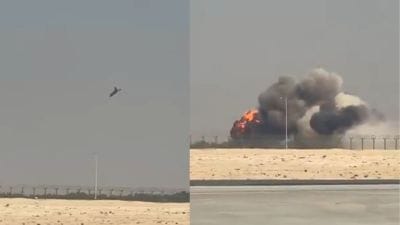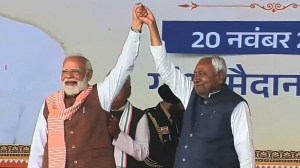Priya Kumari Shukla is a Senior Copy Editor in the Indian Express (digital). She contributes to the UPSC Section of Indian Express (digital) and started niche initiatives such as UPSC Key, UPSC Ethics Simplified, and The 360° UPSC Debate. The UPSC Key aims to assist students and aspirants in their preparation for the Civil Services and other competitive examinations. It provides valuable guidance on effective strategies for reading and comprehending newspaper content. The 360° UPSC Debate tackles a topic from all perspectives after sorting through various publications. The chosen framework for the discussion is structured in a manner that encompasses both the arguments in favour and against the topic, ensuring comprehensive coverage of many perspectives. Prior to her involvement with the Indian Express, she had affiliations with a non-governmental organisation (NGO) as well as several coaching and edutech enterprises. In her prior professional experience, she was responsible for creating and refining material in various domains, including article composition and voiceover video production. She has written in-house books on many subjects, including modern India, ancient Indian history, internal security, international relations, and the Indian economy. She has more than eight years of expertise in the field of content writing. Priya holds a Master's degree in Electronic Science from the University of Pune as well as an Executive Programme in Public Policy and Management (EPPPM) from the esteemed Indian Institute of Management Calcutta, widely recognised as one of the most prestigious business schools in India. She is also an alumni of Jamia Milia Islamia University Residential Coaching Academy (RCA). Priya has made diligent efforts to engage in research endeavours, acquiring the necessary skills to effectively examine and synthesise facts and empirical evidence prior to presenting their perspective. Priya demonstrates a strong passion for reading, particularly in the genres of classical Hindi, English, Maithili, and Marathi novels and novellas. Additionally, she possessed the distinction of being a cricket player at the national level. Qualification, Degrees / other achievements: Master's degree in Electronic Science from University of Pune and Executive Programme in Public Policy and Management (EPPPM) from Indian Institute of Management Calcutta ... Read More
UPSC Key—17 July, 2023: Kuno cheetah deaths, cluster munitions and East Sea naval drills
Exclusive for Subscribers from Monday to Friday: Have you ever thought about how the Cluster Munitions or Northern/Interaction-2023 are relevant to the UPSC Exam? What significance do topics like radio collar, most favoured nation (MFN) and flood control and flood management have for both the preliminary and main exams? You can learn more by reading the Indian Express UPSC Key for July 17, 2023.
 UPSC Key July 2023: Here's what you should be reading from the July 17, 2023 edition of The Indian Express.
UPSC Key July 2023: Here's what you should be reading from the July 17, 2023 edition of The Indian Express. Important topics and their relevance in UPSC CSE exam for July 17, 2023. If you missed the July 14, 2023 UPSC key from the Indian Express, read it here
THE WORLD
Moscow has ‘sufficient stockpile’ of cluster munitions for retaliation: Putin
Syllabus:
Preliminary Examination: Current events of national and international importance.
Main Examination: General Studies II: Effect of policies and politics of developed and developing countries on India’s interests
Key Points to Ponder:
• What’s the ongoing story- Russian President Vladimir Putin said in an interview published on Sunday that Russia has a “sufficient stockpile” of cluster munitions, and warned that Russia “reserves the right to take reciprocal action” if Ukraine uses the controversial weapons.
• What do you understand by the term ‘Cluster Munitions’?
• What is the 2008 Convention on Cluster Munitions?
• For Your Information- According to the Human Rights Watch Cluster munitions pose an immediate threat to civilians during conflict by randomly scattering submunitions or bomblets over a wide area. They continue to pose a threat post-conflict by leaving remnants, including submunitions that fail to explode upon impact becoming de facto landmines. The 2008 Convention on Cluster Munitions prohibits the use, production, transfer, and stockpiling of cluster munitions. It also requires destruction of stockpiles, clearance of areas contaminated by remnants, and victim assistance. More than 120 states have joined the Convention on Cluster Munitions and are working to implement its provisions.
• Why United States has provided cluster munitions to Ukraine?
• For Your Information-Cluster bombs have long been criticized by humanitarian groups, and some US allies, because those used in previous conflicts have had a high “dud rate,” meaning that they often leave behind unexploded bomblets that can harm civilians long after a battle has ended. Proponents argue that Russia has already been using cluster munitions in Ukraine and that the weapons the US is providing have been improved to leave behind far fewer unexploded rounds. Ukraine has promised to use them only away from densely populated areas.
• How Cluster munitions can be harmful for entire Humanity?
• Can You recall any previous use of Cluster munitions?
• Is India a party to the 2008 Convention on Cluster Munitions?
Other Important Articles Covering the same topic:
📍Why the US is willing to send Ukraine cluster munitions now
China, Russia to kick off air, navy drills in East Sea
Syllabus:
Preliminary Examination: Current events of national and international importance.
Main Examination: General Studies II: Effect of policies and politics of developed and developing countries on India’s interests
Key Points to Ponder:
• What’s the ongoing story- A Chinese naval flotilla set off on Sunday to join Russian naval and air forces in the Sea of Japan in an exercise aimed at “safeguarding the security of strategic waterways”, according to China’s defence ministry. Codenamed “Northern/Interaction-2023”, the drill marks enhanced military cooperation between China and Russia since Moscow’s invasion of Ukraine and is taking place as Beijing continues to rebuff U.S. calls to resume military communication.
• Map Work-Sea of Japan, Kanmon Strait, East China Sea, Sea of Okhotsk and Tsugaru Strait
• What is Northern/Interaction-2023?
• Why China and Russia wants “safeguarding the security of strategic waterways”?
• For Your Information-The Chinese flotilla comprised of five warships and four ship-borne helicopters, left the eastern port of Qingdao and will rendezvous with Russian forces in a “predetermined area”, the ministry said on its official WeChat account on Sunday. On Saturday, the ministry said Russian naval and air forces would participate in the drill taking place in the Sea of Japan. This would be the first time both Russian forces take part in the drill, state newspaper Global Times cited military observers as saying. Gromkiy and Sovershenniy, two Russian warships taking part in the Sea of Japan drill, had earlier this month conducted separate training with the Chinese navy in Shanghai on formation movements, communication and sea rescues.
• China and Russia-Some analysts are accusing Russia of becoming a “vassal” of China-Why?
• What does vassal mean?
• How is the term vassal relevant in this context?
Other Important Articles Covering the same topic:
📍C Raja Mohan writes: Russia and China’s plan is to divide and rule the West
FRONT PAGE
After Kuno deaths, radio collars set to be taken off 10 cheetahs
Syllabus:
Preliminary Examination: General issues on Environmental ecology, Bio-diversity and Climate Change
Mains Examination: General Studies III: Conservation, environmental pollution and degradation, environmental impact assessment.
Key Points to Ponder:
• What’s the ongoing story- An exercise to remove radio collars from 10 free ranging cheetahs at Kuno National Park is among measures suggested by wildlife officials in Madhya Pradesh following the death of two cheetahs in three days. Two South African cheetah experts, including one travelling to India this week to aid officials at Kuno, also told The Indian Express that radio collars could be causing problems. The Ministry of Environment, Forest and Climate Change (MoEF&CC), on the other hand, said on Sunday that reports of cheetah deaths due to radio collars were not based on scientific evidence, and that “all mortalities are due to natural causes”.
• What is radio collar?
• What is a radio collar used for?
• Why is a radio collar used in cheetahs?
• How is the radio collar causing infection in cheetahs?
• Expert’s Take-South African cheetah expert Adrian Tordiffe, who was involved in the translocation of the cheetahs from Namibia and South Africa, had at the time claimed to have looked at the video of the two dead cheetahs and made the suggestion that collars may be an issue. Adrian said the cheetahs in Africa were mostly used to dry weather conditions and were experiencing an Indian monsoon for the first time, causing unforeseen problems. “You must also take in stock that cheetahs are also different when it comes to resilience and susceptibility. They are not able to groom themselves as well as other animals and are not as resilient.” Mike Toft, a cheetah expert from South Africa, will be flying down to India on Tuesday and is expected to help the Kuno officials to deal with the situation. An expert in radio collars, Toft was also involved in the translocation project and has looked after some of the cheetahs at his enclosure. “In East Africa, we have similar monsoon conditions as well and face difficulty with radio collars. I have seen cases of infections breaking out in collared cheetahs, lions and dogs. There are multiple factors like the fit of the collar, long periods of a wet environment, which can cause chafing and discomfort. During the wet weather, the skin becomes thin and once it breaks, there is a risk of flies infecting the injured part, resulting in a maggot infestation. These collars are relatively large satellite tracking collars and we need to check if the collars are a contributing factor to the infection. We need to remove the collars for the monsoon and keep the cheetahs under monitoring,” Toft said. Toft also indicated the challenges in tracking cheetahs without the presence of radio collars – he said that the collars are a “necessary evil” that have to be used to monitor the animals during a translocation and have to be kept on for at least a period of six months. “We did not think of this when we were translocating the cheetahs. In Mozambique, we have wet weather conditions, but not a lot of cheetahs are collared. In this project, a large number of cheetahs are collared. It is an unforeseen problem,” he said.
• What is the Reintroduction of the cheetah in India plan?
• Cheetah in India- Background
• Extinction of Cheetah from Indian Landscape-know the reasons
• Action Plan for Introduction of Cheetah in India-Important Highlights
• Know the difference between cheetah and Leopard and African cheetah and Asiatic cheetah
• Supreme Court of India on Translocating Animals-know in detail
• Trans-continental translocation of Animals-know the Issues and Challenges
• Map Work World-South Africa, Namibia and Botswana
• Map Work India-Kuno Palpur National Park (Madhya Pradesh)
• For Your Information-Cheetahs are among the oldest of the big cat species, with its ancestors going back about 8.5 million years. It is listed as “vulnerable” by the World Conservation Union (IUCN) Red List of Threatened Species. Two subspecies, the Asiatic cheetah and the Northwest African cheetah, are listed as “critically endangered”.
Other Important Articles Covering the same topic:
📍The 360° UPSC Debate: Project Cheetah — Is it problematic, or is it too early to judge?
UK FTA: Template for other trade pacts in mind, India moves cautiously
Syllabus:
Preliminary Examination: Economic and Social Development
Main Examination: General Studies II: Bilateral, regional and global groupings and agreements involving India and/or affecting India’s Interest
Key Points to Ponder:
• What’s the ongoing story- AS INDIA AND the UK engage in negotiations to resolve contentious issues in the ongoing talks for the India-UK Free Trade Agreement (FTA), the overarching focus from New Delhi’s perspective is to ensure a comprehensive deal without ceding too much ground, given that this deal will serve as a template for all upcoming trade pacts, including ones being discussed with the EU (European Union) and the EFTA (European Free Trade Association) countries viz., Iceland, Liechtenstein, Norway and Switzerland.
• India-UK Free Trade Agreement (FTA)-Know in detail
• What are the contentious issues in the ongoing talks for the India-UK Free Trade Agreement (FTA)?
• What is Rules of origin?
• Do You Know-Rules of origin — the criteria that determine the national source of a product — have been among the most contentious issues for the FTA talks with the UK. These are important in trade negotiations since countries levy duties or impose restrictions on products based on the source of imports. In addition, India’s commerce and tax officials are negotiating on the crucial aspects of duty cuts for alcohol/whisky from the UK that could have an impact on the local bottling industry, the official said, adding that the pace of negotiations has been decidedly kept slow for this reason.
• What is preferential treatment in Free Trade Agreement?
• What is the most Favoured nation (MFN) principle?
• What are the benefits of MFN?
• For Your Information-The MFN concept requires countries that are part of the World Trade Organisation to accord the most favourable tariff and regulatory treatment given to the products or services of any one member at the time of import or export of “like products” to all other members. This is a bedrock principle of the WTO and would also be a factor for New Delhi as it negotiates multiple negotiations at the same time. Others are well within their rights to seek a concession extended by a WTO signatory to another member nation/ bloc.
• India and the UK are looking to close negotiations over five chapters dealing with contentious issues such as digital trade, environment and labour in the ongoing negotiations-Know more in detail
• Do You Know-In 2022-23, India-UK bilateral trade had increased 16 per cent to US $20.36 billion. India’s exports were $11.4 billion in 2022-23 compared with $10.5 billion the previous year; and its imports stood at US $8.96 billion during 2022-23 compared with US $7 billion in 2021-22.
• Know about other types of trade agreements like Bilateral investment treaty (BIT), Preferential Trade Area, Single market, Customs Union etc.
• What is Definition of trade given by WTO?
• Enhanced Trade Partnership between India and UK
• India and UK trade-know in brief
• Significance of India-UK Trade Relations
• India and Regional Comprehensive Economic Partnership (RCEP)
Other Important Articles Covering the same topic:
📍India & UK look to close FTA talks on five chapters with contentious issues
June sees spike in households taking up NREGS work, poor monsoon one reason
Syllabus:
Preliminary Examination: Economic and Social Development
Main Examination: General Studies II: Important aspects of Governance and Welfare schemes for vulnerable sections of the population by the Centre and States and the performance of these schemes
Key Points to Ponder:
• What’s the ongoing story- THE NUMBER OF households availing jobs under the Mahatma Gandhi National Rural Employment Guarantee Scheme (MG-NREGS) jumped over 10 per cent to touch 3.04 crore in June this year compared with last June. This is the highest monthly numbers in the last three years, and only the third time since April 2014 – the earliest from when monthly figures are available on the NREGS dashboard — to cross 3 crore.
• But why such spike?
• For Your Information-Devendra Kumar Pant, Chief Economist, India Ratings, said the sharp increase in demand in June can be because of a weak monsoon, due to which kharif sowing was affected. Due to uneven rainfall distribution in June, sowing got delayed and hence people might have opted for NREGS, he said. With the rainfall deviation going down in July, the number is expected to decline, he told The Indian Express. Pronab Sen, former Chief Statistician of India, said the jump can be due to two reasons; one, elevated rural unemployment that aggravated due to Covid-19, and timely release of funds by the Centre to states. Sequentially too, the NREGS beneficiaries have increased since April this year. In April 2023, 2.07 crore families took to the scheme, and in May 2023, as many as 2.86 crore families availed of it. Of the 3.03 crore families in June 2023, Tamil Nadu had the highest share of 17 per cent or 51.80 lakh families, followed by Andhra Pradesh 33.14 lakh, Rajasthan 32.68 lakh, Uttar Pradesh 32.10 lakh, and Bihar 22.36 lakh. In as many as 10 states, over a million families availed the scheme in June.
• Mahatma Gandhi National Rural Employment Guarantee Act (MGNREGA)-Mandate, Goals
• What are the core objectives of the Mahatma Gandhi National Rural Employment Guarantee Scheme (MGNREGS)?
• When was Mahatma Gandhi National Rural Employment Guarantee Act passed by the Indian Parliament?
• What is the relationship between the Mahatma Gandhi National Rural Employment Guarantee Act (Mahatma Gandhi NREGA) and the Mahatma Gandhi National Rural Employment Guarantee Scheme (Mahatma Gandhi NREGS)?
• In what way paradigm shift has taken place with the implementation of MGNREGA?
• Who are the key stakeholders of MGNREGS?
• What is the role of Gram Sabha and Gram Panchayat in MGNREGS?
• How is Household defined in MGNREGA?
• Issues with MGNREGA?
• What are the eligibility criteria for receiving the benefits under MGNREGA scheme?
• Mahatma Gandhi National Rural Employment Guarantee Act (MGNREGA)-Nodal Ministry
• COVID-19 pandemic and its impact on MGNREGA?
• Mahatma Gandhi National Rural Employment Guarantee Act (MGNREGA) and Social Audit
• After a dip in demand for work under Mahatma Gandhi National Rural Employment Guarantee Scheme (MG-NREGS) the demand for work has again seen a rise-Know the reasons
• How schemes such as MGNREGA can help alleviate distress migration?
• For Your Information-The Mahatma Gandhi National Rural Employment Guarantee Act guarantees 100 days of wage employment in a financial year to every rural household whose adult members volunteer to do unskilled manual work. The scheme emerged as a safety net for poor and migrant workers who returned to their villages in the wake of the Covid-19 pandemic. In 2020-21, which witnessed the outbreak of Covid-19 and subsequent nationwide lockdown, the number of families availing the scheme hit an all-time high of 7.5 crore. It was 7.25 crore in 2021-22 and 6.18 crore in 2022-23.
Other Important Articles Covering the same topic:
📍Budget 2023 cuts MGNREGS funds: The debate around the rural employment scheme
THE EDITORIAL PAGE
Syllabus:
Preliminary Examination: Current events of national and international importance.
Mains Examination: General Studies II: Bilateral, regional and global groupings and agreements involving India and/or affecting India’s interests.
Key Points to Ponder:
• What’s the ongoing story– Mohan Kumar writes: While India has more than 30 strategic partnerships with various countries, it would be misleading to say that they all are of the same significance. Two questions are crucial in this context. One, is it a full-spectrum strategic partnership? Two, has the strategic partnership in question stood the test of time? Measured against these two criteria, the Franco-Indian strategic partnership comes out on top. The Franco-Indian partnership spans the full spectrum of what may be considered strategic — defence, space, climate change, critical technologies and people-to-people ties. More importantly, France has stood by India through thick and thin from the time the strategic partnership was first established in 1998.
• Full-spectrum strategic partnership-What have understood by this statement?
• Franco-Indian partnership-Analyse
• In the backdrop of the 25th anniversary of the India–France strategic partnership, examine India-France bilateral relations
• PM Modi’s visit to France-why?
• PM Modi’s Visit to France-what are the key takeaways
• 25-year vision statement for India-France bilateral ties-What do you know about this?
• Some Highlights-Prime Minister Narendra Modi has just concluded a hugely significant visit to France. For once, words like “unprecedented” and “historic” used are not just hyperbole. This was after all France, so of course, there was pomp and circumstance. France bestowed on PM Modi the highest civilian honour. Our tri-services contingent, which marched past Champs-Elysees, must have made every Indian’s heart swell with pride. Three documents, namely, the joint communique, the Horizon 2047 roadmap and the list of specific outcomes put out by the two sides is enough to overwhelm even the most inveterate policy wonk. Some have compared this visit to the one that PM Modi undertook to the US not so long ago. It should be obvious that the fact that PM Modi went to France so close on the heels of the US is the ultimate expression of India’s strategic autonomy.
The defence sector always grabs attention at Franco-Indian summits and this was no exception. Key agreements: Safran, the French company and the DRDO (Defence Research and Development Organisation) will jointly develop jet engines for the advanced medium combat aircraft. In all of the above, the main takeaway is this: Franco-Indian defence ties have truly moved from a mere buyer-seller model to that of jointly designing, developing and co-producing it in India. This is a paradigmatic shift from the French side in terms of willingness to part with know-how and state-of-the-art technology.
• The Indo-Pacific, predictably enough, occupied centre stage in discussions between the two leaders-What was discussed on this?
• What are the main areas where the two countries cooperate?
• What are the challenges observed in the bilateral relations between India and France?
• In the context of a multipolar world, what is India’s Geopolitical position?
• Is India shifting towards West?
Other Important Articles Covering the same topic:
THE IDEAS PAGE
Syllabus:
Preliminary Examination: Indian and World Geography-Physical, Social, Economic Geography of India and the World.
Mains Examination:
• General Studies I: Urbanization, their problems and their remedies.
• General Studies I: Important Geophysical phenomena such as earthquakes, Tsunami, Volcanic activity, cyclone etc., geographical features and their location-changes in critical geographical features and in flora and fauna and the effects of such changes.
• General Studies III: Disaster and disaster management.
Key Points to Ponder:
• What’s the ongoing story- This year the monsoon began unusually. After 61 years, it arrived in Mumbai and New Delhi on the same day — June 24. The monsoon’s onset in these cities is generally around June 10 and June 30, respectively. Immediately after its arrival, many places across India received heavy to very heavy rainfall. It is unusual to see flooded rivers and cities in June/early July since most of the flooding usually occurs in the later months of the monsoon.
• Studies and expert appraisals have concluded that citizens, properties, and infrastructure in India cannot be provided with complete flood protection-why?
• Why there is a need to shift attention and efforts from flood control to flood management?
• What is flood control and management?
• What is the difference between flood control and flood management?
• What are the flood management procedures?
• A range of tools are available to manage floods-what are they?
• For Your Information-A range of tools are available to manage floods. Broadly, these are classified as structural and non-structural. Structural measures include storage reservoirs, embankments, and diversions. These reduce flood hazards by keeping damage-causing waters away from agricultural areas, cities, industries, etc. Storage reservoirs moderate the flood peak by storing water during high-flow periods and releasing it after they have subsided. They also conserve water for irrigation, electricity generation, water supply, etc. Their effectiveness in flood moderation depends on the space available. In addition, tanks and ponds are traditional means of water conservation in India. They also aid in groundwater recharge and promote biodiversity. Non-structural methods such as flood forecasting, warnings, and flood plain zoning, help in the timely evacuation of people and regulate the use of floodplains. Note that floods are a hazard only when people go close to flood waters or hinder their movement. A forecasting and warning system provides a priori estimate of approaching floods so that people and movable assets are relocated to safer places in time. India has more than 5,500 large dams. Accurate inflow forecasts help moderate floods by estimating the space needed for storage in reservoirs. A common saying goes: “Floods are acts of God but flood losses are largely acts of man”. Non-structural methods don’t involve construction and hence don’t create an adverse impact on the environment or otherwise. However, the resource (water) is neither conserved nor put to alternate use. Large and medium water conservancy projects can save huge quantities of damage-causing water. So, to manage increasing variabilities, existing infrastructure should be upgraded or new infrastructure created.
Other Important Articles Covering the same topic:
📍Express view on monsoon-battered India: Weathering it out
EXPLAINED
Debate over definition of ‘child’, age of consent in data protection Bill
Syllabus:
Preliminary Examination: Current events of national and international importance
Main Examination: General Studies II: Government policies and interventions for development in various sectors and issues arising out of their design and implementation.
Key Points to Ponder:
• What’s the ongoing story-The upcoming data protection Bill could empower the Central government to lower the age of consent from 18, for accessing Internet services without parental oversight. It could also exempt certain companies from adhering to additional obligations for protecting kids’ privacy if they can process their data in a “verifiably safe” manner. This marks a key departure from the previous data protection Bill that was floated in 2022 where the threshold of children’s age was hard-coded at 18 years. The change, however, is in line with data protection regulations in the Western world, with regions like the European Union and the United States prescribing a lower age of consent. Lowering the age of consent under the 2022 draft had been a key ask of the industry, especially social media companies, as a hard-coded age of consent would have meant business disruptions for them on account of setting up new systems for obtaining parental consent for users under 18 years of age — a key demographic for such services.
• How the definition of a child kept changing?
• What did the Justice BN Srikrishna committee report say on Children and on the age of consent?
• How the world defines children in data protection regulations
• What is the age of consent in India?
• Do children have right to privacy in India?
• For Your Information-The change is a major departure from the draft Digital Data Protection Bill, 2022 that was floated last November, under which the age of consent was hardcoded at 18 years – meaning that for processing data of individuals below the age of 18, companies were required to seek their parents’ consent. The upcoming Bill, it is understood, will take a graded approach to defining the age of consent on a case-by-case basis.
• What is the definition of a child under the data protection bill?
• Do You Know-Under the European Union’s General Data Protection Regulation (GDPR), age of consent has been kept at 16, but it allows member states to lower it to as much as 13. The United States’ Children’s Online Privacy Protection Act (COPPA) has capped the age of consent at 13, and verifiable parental consent is needed only for those who are younger. Other key changes to the upcoming Bill include further relaxations to cross-border data flows to international jurisdictions – by moving away from a whitelisting approach, to a blacklisting mechanism, as reported earlier by this newspaper.
• The government withdrew the earlier Personal Data Protection Bill from Parliament. Why did the Government withdrawn the Personal Data Protection Bill?
• Joint Committee of Parliament Report on the Personal Data Protection Bill-Know key highlights
• Supreme Court on Right to Privacy (Justice K.S. Puttaswamy vs. Union of India, 2017)-know the verdict
• Justice B N Srikrishna committee recommendation on Data Protection-Know key recommendations
Other Important Articles Covering the same topic:
📍Explained: The issues, debate around Data Protection Bill
📍What Data Protection Bill needs to do to actually protect
For any queries and feedback, contact priya.shukla@indianexpress.com
The Indian Express UPSC Hub is now on Telegram. Click here to join our channel and stay updated with the latest Updates.
UPSC Magazine

Read UPSC Magazine



- 01
- 02
- 03
- 04
- 05





























